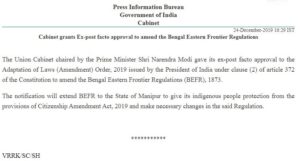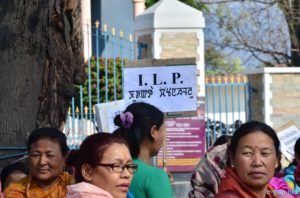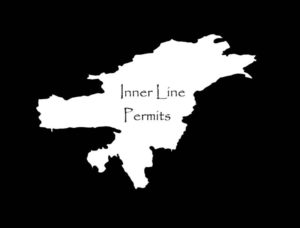NE UpdatesBarak UpdatesIndia & World UpdatesAnalyticsBreaking NewsFeature Story
Assam removed from preamble of the Bengal Eastern Frontier Regulation 1873, writes Urmisree Deb

December 27: Way back in the 18th Century, when India was neither a country nor a legal State, there came a law canon by the Her Majesty, Queen Victoria to safeguard, through punitive regulatory provisions, aimed at regulating transit facilities to non-hill people into the hills and the entire North Eastern Region through the Bengal Eastern Frontier Regulation, 1873. Bengal Eastern Frontier Regulation was enacted on 27 August, 1873 for the peace and governance of certain districts on the Eastern Frontier of Bengal.

 This Regulation very commonly known as “Inner Line Permit System” was extended to the districts named in the preamble, and which became effective from 1 November, 1873. Under this Regulation, the British framed regulations restricting the entry and regulating the stay of outsiders in designated areas. This was to protect the Crown’s own commercial interests by preventing “British subjects” (Indians) from trading within these regions.
This Regulation very commonly known as “Inner Line Permit System” was extended to the districts named in the preamble, and which became effective from 1 November, 1873. Under this Regulation, the British framed regulations restricting the entry and regulating the stay of outsiders in designated areas. This was to protect the Crown’s own commercial interests by preventing “British subjects” (Indians) from trading within these regions.
 After independence, the Indian state retained this in the constitution. Article 372(2) of the Indian Constitution empowered the President by order to make such adaptations and modifications of any law in force in the territory of India, whether by way of repeal or amendment as may be necessary or expedient for the purpose of bringing the provisions of such law into accord as from such date as may be specified in the Order, have effect subject to the adaptations and modifications so made.
After independence, the Indian state retained this in the constitution. Article 372(2) of the Indian Constitution empowered the President by order to make such adaptations and modifications of any law in force in the territory of India, whether by way of repeal or amendment as may be necessary or expedient for the purpose of bringing the provisions of such law into accord as from such date as may be specified in the Order, have effect subject to the adaptations and modifications so made.
 In exercise of the powers conferred by the Constitution and of all other persons enabling him in that behalf, the President of India makes the Adaptation of Laws Order, 1950 and which became effective from the 26th day of January, 1950. In the Third Schedule to the Adaptation of Laws Order, 1950, for the directions relating to the Bengal Eastern Frontier Regulation, 1873, the phrase “British subject” was replaced with “Indian citizens” and “excluded areas” beyond the pale of administration now became “protected areas” whose distinct identity had to be preserved.
In exercise of the powers conferred by the Constitution and of all other persons enabling him in that behalf, the President of India makes the Adaptation of Laws Order, 1950 and which became effective from the 26th day of January, 1950. In the Third Schedule to the Adaptation of Laws Order, 1950, for the directions relating to the Bengal Eastern Frontier Regulation, 1873, the phrase “British subject” was replaced with “Indian citizens” and “excluded areas” beyond the pale of administration now became “protected areas” whose distinct identity had to be preserved.
 The recent developments in the backdrop of the Government of India getting the Citizenship (Amendment) Act passed in Parliament, which also saw the Centre simultaneously extending provisions of the Bengal Eastern Frontier Regulation, 1873 to introduce Inner Line Permit mechanism to Manipur on 11 December,2019 with President Ram Nath Kovind signing the order in this effect. A notification in this regard was issued by the Home Ministry. According to this Gazette notification, “In the Third Schedule to the Adaptation of Laws Order, 1950, for the directions relating to the Bengal Eastern Frontier Regulation, 1873, the following shall be substituted, namely: – ‘Preamble.– In the opening paragraph, for “districts of Kamrup, Darrang, Nowgong, Sibsagar, Lakhimpur, Naga Hills, Cachar” substitute “States of Arunachal Pradesh, Manipur, Mizoram and area of districts of State of Nagaland as notified from time to time.”
The recent developments in the backdrop of the Government of India getting the Citizenship (Amendment) Act passed in Parliament, which also saw the Centre simultaneously extending provisions of the Bengal Eastern Frontier Regulation, 1873 to introduce Inner Line Permit mechanism to Manipur on 11 December,2019 with President Ram Nath Kovind signing the order in this effect. A notification in this regard was issued by the Home Ministry. According to this Gazette notification, “In the Third Schedule to the Adaptation of Laws Order, 1950, for the directions relating to the Bengal Eastern Frontier Regulation, 1873, the following shall be substituted, namely: – ‘Preamble.– In the opening paragraph, for “districts of Kamrup, Darrang, Nowgong, Sibsagar, Lakhimpur, Naga Hills, Cachar” substitute “States of Arunachal Pradesh, Manipur, Mizoram and area of districts of State of Nagaland as notified from time to time.”
 The Union Cabinet chaired by the Prime Minister Narendra Modi on 24th day of December, 2019 also gave its approval to amend the Bengal Eastern Frontier Regulations, 1873. So, Manipur is the fourth state after Arunachal Pradesh, Nagaland and Mizoram where the ILP regime is applicable. The Inner Line Permit is a document that allows an Indian citizen to go or live in a protected state under the ILP system for a specific period of time. An ILP is issued by the state government concerned. It can be obtained after applying either online or physically. It states the dates of travel and also specifies the particular areas in the state which the ILP holder can travel to.
The Union Cabinet chaired by the Prime Minister Narendra Modi on 24th day of December, 2019 also gave its approval to amend the Bengal Eastern Frontier Regulations, 1873. So, Manipur is the fourth state after Arunachal Pradesh, Nagaland and Mizoram where the ILP regime is applicable. The Inner Line Permit is a document that allows an Indian citizen to go or live in a protected state under the ILP system for a specific period of time. An ILP is issued by the state government concerned. It can be obtained after applying either online or physically. It states the dates of travel and also specifies the particular areas in the state which the ILP holder can travel to.
 It may be mentioned here that in section 6B (4) of the citizenship Act, 1955 as amended up-to-date, it has been stated that ” Nothing in this section shall apply to tribal area of Assam Meghalaya, Mizoram or Tripura as included in the Sixth Schedule to the Constitution and the area covered under “The Inner Line” Notified under the Bengal Eastern Frontier Regulation 1873″
It may be mentioned here that in section 6B (4) of the citizenship Act, 1955 as amended up-to-date, it has been stated that ” Nothing in this section shall apply to tribal area of Assam Meghalaya, Mizoram or Tripura as included in the Sixth Schedule to the Constitution and the area covered under “The Inner Line” Notified under the Bengal Eastern Frontier Regulation 1873″
 The origin of sixth schedule can be traced back to policy of exclusion of the British Government in the colonial period. Under the Govt. of India Act, 1935, the hill areas of Assam were divided into two categories-Excluded and Partially Excluded Areas and remained outside the process of development. After Independence, there were demands for regional autonomy and better status within the constitutional framework from the tribes of the hill areas of Assam. The Interim Government of India was sensitive to the political aspirations of the tribal people of the hill areas of Assam in the background of assurances given by the outgoing British rulers.
The origin of sixth schedule can be traced back to policy of exclusion of the British Government in the colonial period. Under the Govt. of India Act, 1935, the hill areas of Assam were divided into two categories-Excluded and Partially Excluded Areas and remained outside the process of development. After Independence, there were demands for regional autonomy and better status within the constitutional framework from the tribes of the hill areas of Assam. The Interim Government of India was sensitive to the political aspirations of the tribal people of the hill areas of Assam in the background of assurances given by the outgoing British rulers.
 An advisory committee on Fundamental Rights of Minorities in the Tribal Areas was constituted in May 1946 by the Constituent Assembly of India. One of the sub-committees constituted by the Advisory Committee was the Northeast Frontier (Assam) Tribal and Excluded Areas Sub-Committee under the chairmanship of Assam Premier, Gopinath Bordoloi. The recommendation made on the basis of the observation made by the subcommittee became the substance of the Sixth Schedule. After independence, these areas got special administrative machinery in the form of the Sixth Schedule which provided for District and Regional Councils for administration of these erstwhile excluded areas. These institutions were expected to integrate these areas with the modern system of administration while preserving the traditional autonomy and local self-governing institutes of the tribal people.
An advisory committee on Fundamental Rights of Minorities in the Tribal Areas was constituted in May 1946 by the Constituent Assembly of India. One of the sub-committees constituted by the Advisory Committee was the Northeast Frontier (Assam) Tribal and Excluded Areas Sub-Committee under the chairmanship of Assam Premier, Gopinath Bordoloi. The recommendation made on the basis of the observation made by the subcommittee became the substance of the Sixth Schedule. After independence, these areas got special administrative machinery in the form of the Sixth Schedule which provided for District and Regional Councils for administration of these erstwhile excluded areas. These institutions were expected to integrate these areas with the modern system of administration while preserving the traditional autonomy and local self-governing institutes of the tribal people.
 The provision of Sixth Schedule, however, resulted in violence, displacement and loss of trust between different communities. The Sixth Schedule of the Constitution deals with the administration of the tribal areas in the four northeastern states of Assam, Meghalaya, Tripura and Mizoram as per Article 244. The 10 autonomous district councils in four states are: 1) Assam: Bodoland Territorial Council, Karbi Anglong Autonomous Council and Dima Hasao Autonomous District Council. 2) Meghalaya: Garo Hills Autonomous District Council, Jaintia Hills Autonomous District Council and Khasi Hills Autonomous District Council. 3) Tripura: Tripura Tribal Areas Autonomous District Council. 4) Mizoram: Chakma Autonomous District Council, Lai Autonomous District Council, Mara Autonomous District Council.
The provision of Sixth Schedule, however, resulted in violence, displacement and loss of trust between different communities. The Sixth Schedule of the Constitution deals with the administration of the tribal areas in the four northeastern states of Assam, Meghalaya, Tripura and Mizoram as per Article 244. The 10 autonomous district councils in four states are: 1) Assam: Bodoland Territorial Council, Karbi Anglong Autonomous Council and Dima Hasao Autonomous District Council. 2) Meghalaya: Garo Hills Autonomous District Council, Jaintia Hills Autonomous District Council and Khasi Hills Autonomous District Council. 3) Tripura: Tripura Tribal Areas Autonomous District Council. 4) Mizoram: Chakma Autonomous District Council, Lai Autonomous District Council, Mara Autonomous District Council.
 In Assam too, there have been demands by certain sections/groups for the introduction of ILP. Groups like the Asom Jatiyatabadi Yuba Chatra Parishad, a youth organization has been organising protest demonstrations seeking ILP throughout the state. But in my opinion, the Central Government will permanently block the way of reintroduction of Inner Line Permit in the State of Assam by the Adaptation of Laws (Amendment) Order,2019. The implementation of inner line permit will isolate Manipur, Arunachal Pradesh, Nagaland and Mizoram and create hindrance for its economic development.
In Assam too, there have been demands by certain sections/groups for the introduction of ILP. Groups like the Asom Jatiyatabadi Yuba Chatra Parishad, a youth organization has been organising protest demonstrations seeking ILP throughout the state. But in my opinion, the Central Government will permanently block the way of reintroduction of Inner Line Permit in the State of Assam by the Adaptation of Laws (Amendment) Order,2019. The implementation of inner line permit will isolate Manipur, Arunachal Pradesh, Nagaland and Mizoram and create hindrance for its economic development.

(Views expressed in this article are solely of the author and does not necessarily reflect the views of the portal)




